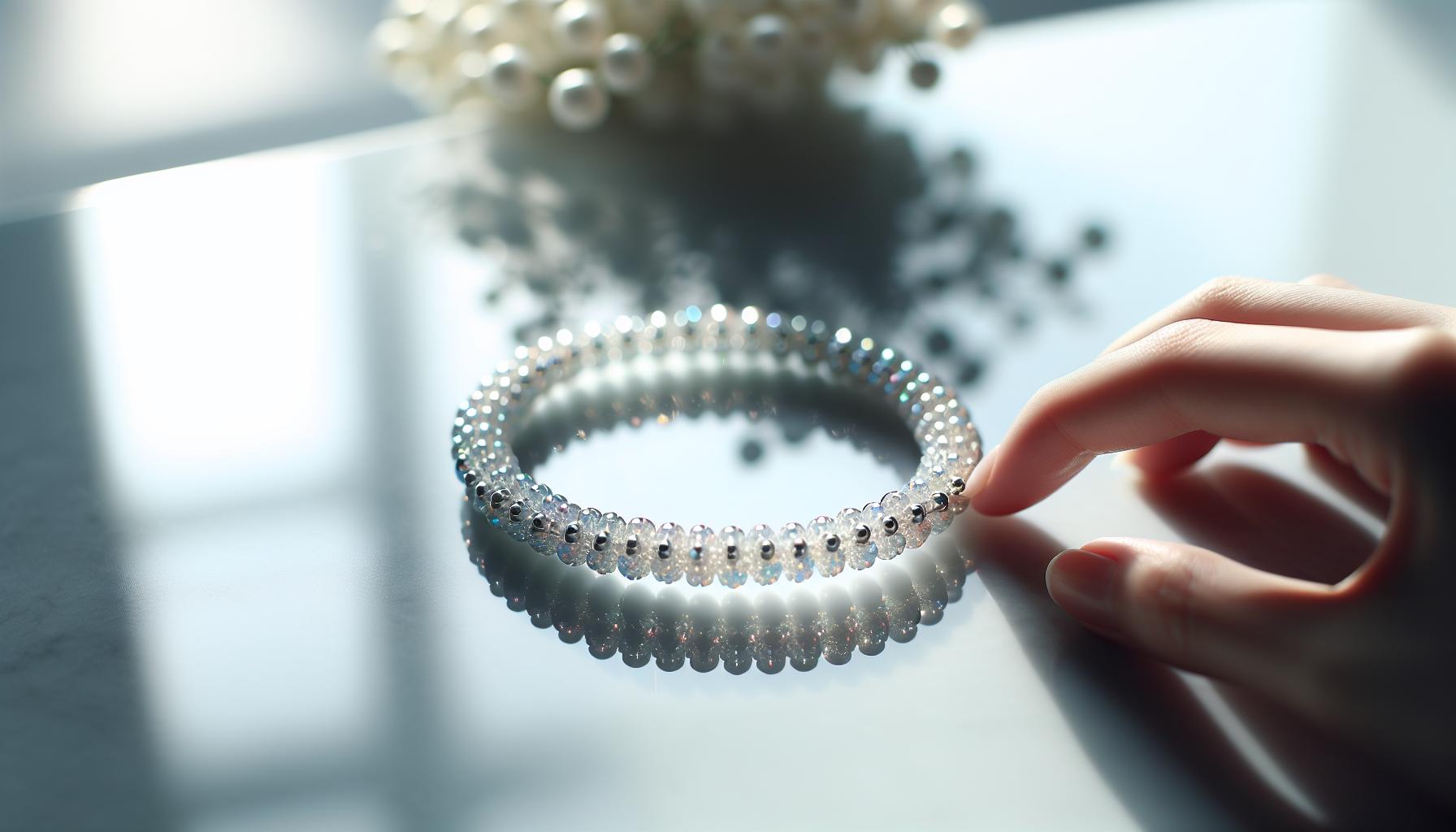Imagine you’re shopping for a new bracelet and pondering over its weight. Whether you’re a fan of delicate, dainty pieces or prefer something chunkier and more substantial, the weight of a bracelet can greatly impact the overall wearing experience. In this article, we’ll explore the topic of bracelet weights, discussing how different materials, designs, and sizes can influence the weight of this cherished accessory. So, if you’ve ever wondered how much your bracelet weighs, join us as we unravel the secrets behind this often overlooked aspect of jewelry.
SONGMICS Jewelry Box Organizer with Glass Lid, 3-Layer Jewelry Storage, with 2 Drawers, Modern Style, Christmas Gift, 8 x 9.1 x 5.3 Inches, Cloud White and Gold Color UJBC239WT
$29.99 (as of November 28, 2025 16:28 GMT +00:00 - More infoProduct prices and availability are accurate as of the date/time indicated and are subject to change. Any price and availability information displayed on [relevant Amazon Site(s), as applicable] at the time of purchase will apply to the purchase of this product.)Rotating Jewelry Box Large Capacity with Mirror, 4-Layer Rotating Jewelry Storage Box for Bracelets Rings Earrings, Gift for Women, Blue
$0.96 (as of November 28, 2025 16:28 GMT +00:00 - More infoProduct prices and availability are accurate as of the date/time indicated and are subject to change. Any price and availability information displayed on [relevant Amazon Site(s), as applicable] at the time of purchase will apply to the purchase of this product.)Jewelry Dish Tray, Ring Dish, Ceramic Trinket Tray, Key Bowl, Decorative Plate, for Friends Sisters Daughter Mother (Milky White)
$5.99 (as of November 28, 2025 16:28 GMT +00:00 - More infoProduct prices and availability are accurate as of the date/time indicated and are subject to change. Any price and availability information displayed on [relevant Amazon Site(s), as applicable] at the time of purchase will apply to the purchase of this product.)Benevolence LA Plush Velvet Jewelry Box | Travel Jewelry Case Organizer with Mirror | Featured in Oprah's Favorite Things | Best Gifts For Daughter, Girlfriend, Mom | Gifts For Her - Dusty Pink
$15.74 (as of November 28, 2025 16:28 GMT +00:00 - More infoProduct prices and availability are accurate as of the date/time indicated and are subject to change. Any price and availability information displayed on [relevant Amazon Site(s), as applicable] at the time of purchase will apply to the purchase of this product.)Purple Flower Jewelry Dish Glass Ring Holder Dish Jewelry Tray Cute Vanity Organizer Aesthetic Nightstand Bathroom Room Decor Trinket Dish Valentine's Friendship Christmas Birthday Gifts for Women
$6.31 (as of November 28, 2025 16:28 GMT +00:00 - More infoProduct prices and availability are accurate as of the date/time indicated and are subject to change. Any price and availability information displayed on [relevant Amazon Site(s), as applicable] at the time of purchase will apply to the purchase of this product.)
Factors that Affect Bracelet Weight
Bracelets come in various shapes, sizes, and materials, and these factors can greatly influence the overall weight of the piece. Understanding the factors that determine bracelet weight is crucial for choosing the perfect bracelet that suits your preferences. Here are the key elements that affect the weight of a bracelet:
Materials Used
One of the primary factors that determine the weight of a bracelet is the material used in its construction. Different materials have different densities, which directly impacts the weight of the bracelet. Common materials used in bracelets include gold, silver, stainless steel, leather, and beads. Each material has its own unique heaviness, and this contributes significantly to the overall weight of the bracelet.
Design and Style
The design and style of a bracelet also play a significant role in its weight. Bracelets with intricate designs that feature multiple components tend to be heavier compared to simpler and sleeker designs. Bracelets with larger and bulkier elements or embellishments will naturally be heavier, while those with minimalistic designs tend to be lighter.
Size
The size of a bracelet directly impacts its weight. Typically, larger bracelets will be heavier due to the additional material used to accommodate the increased size. However, it is essential to note that even bracelets of the same size but made from different materials can vary in weight due to differences in material density.
Type of Closure
The type of closure used in a bracelet can affect both its weight and its overall comfort. Bracelets that incorporate heavier clasps or multiple closures may weigh more than those with simpler closure mechanisms. Magnetic closures, for example, can add extra weight to the bracelet.
Additional Features
Bracelets with additional features, such as charms, gemstones, or engravings, can also contribute to the overall weight of the piece. The weight of these additional features will depend on their size and material composition. It’s important to consider these factors when selecting a bracelet, as they can affect both the comfort and the aesthetics of the jewelry piece.
Weight of Different Bracelet Materials
When examining the weight of different bracelets, it is important to consider the specific material used. Let’s take a closer look at some common materials used in bracelet construction and their associated weights:
Gold Bracelets
Gold bracelets can vary significantly in weight depending on the karatage of the gold used. Higher karat gold tends to be denser and, therefore, heavier. For example, an 18-karat gold bracelet will generally be heavier than a 14-karat gold bracelet of the same design and size.
Silver Bracelets
Silver is a relatively lightweight material, making silver bracelets generally lighter compared to gold bracelets. However, like gold, the thickness and design of the bracelet can affect its weight. Sterling silver bracelets, which contain 92.5% pure silver, are a popular choice due to their durability and moderate weight.
Stainless Steel Bracelets
Stainless steel bracelets are known for their durability and resistance to tarnish, making them a popular choice for both men and women. Stainless steel is a relatively lightweight material, often making these bracelets more comfortable to wear for extended periods. They offer a modern and sleek look without adding excessive weight to the wrist.
Leather Bracelets
Leather bracelets are known for their casual and versatile appearance. They tend to be lightweight because they are primarily made of leather combined with minimal metal or decorative elements. The specific leather used can affect the weight, as some leathers are denser and heavier than others.
Beaded Bracelets
Beaded bracelets can vary significantly in weight depending on the type and size of the beads used. Bracelets made with larger beads or heavier materials, such as gemstones or glass, will naturally be heavier compared to those with smaller or lighter beads. Beaded bracelets can provide a lightweight option while still adding a pop of color and style to your wrist.
Specialty Bracelets
Beyond the materials used, various bracelet styles have their own unique weights. Let’s explore some specialty bracelets and their associated weights:
Charm Bracelets
Charm bracelets are adorned with various charms and can be personalized to reflect the wearer’s personality and interests. The weight of a charm bracelet will depend on the number and size of the charms added. As charms can vary significantly in weight, it is essential to consider this when wearing a charm bracelet.
Anklets
Anklets, also known as ankle bracelets, are worn around the ankle and are usually lighter compared to bracelets worn on the wrist. Anklet weights can vary depending on the materials used and the size of the anklet. Delicate chains or simple beaded designs are typically lighter, while anklets with larger charms or multiple chains may be slightly heavier.
Bangle Bracelets
Bangle bracelets are circular bracelets that are rigid and slip over the hand onto the wrist. These bracelets can vary in weight depending on the thickness and material used in their construction. Thicker and wider bangles made of heavier materials, like solid gold or sterling silver, will be heavier compared to thinner and lighter bangles.
Tennis Bracelets
Tennis bracelets feature a continuous line of individually set gemstones, typically diamonds, along the entirety of the bracelet. The weight of a tennis bracelet will depend on the number and size of the gemstones used. Higher carat weights or larger gemstones will naturally add more weight to the bracelet.
Average Weight of Common Bracelet Styles
Certain bracelet styles have become iconic and are favored by many individuals worldwide. Understanding the average weight of these common bracelet styles can help you make an informed decision when selecting a bracelet. Here are some popular bracelet styles and their average weights:
Chain Bracelets
Chain bracelets come in various thicknesses and link styles, leading to variations in weight. On average, a simple chain bracelet made of gold or silver can weigh between 5 to 15 grams, depending on the size and width of the links.
Cuff Bracelets
Cuff bracelets are wide, open-ended bracelets that wrap around the wrist. These bracelets can feature intricate designs or be minimalist in style. Due to their larger size and often substantial thickness, cuff bracelets can weigh anywhere from 15 to 40 grams, depending on the materials used.
Bangle Bracelets
As mentioned earlier, bangle bracelets can vary in weight depending on their thickness and material. On average, a solid gold or silver bangle bracelet can weigh between 10 to 30 grams, with wider or heavier designs tipping towards the higher end of the weight spectrum.
Beaded Bracelets
Beaded bracelets offer a lighter option compared to other styles. On average, beaded bracelets can weigh between 3 to 10 grams, depending on the type, size, and number of beads used. Lighter materials such as wood or acrylic beads will contribute less weight compared to gemstone or metal beads.

Comparing Bracelet Weight to other Jewelry
Understanding how bracelet weights compare to other types of jewelry can provide context when considering overall comfort and wearability. Let’s briefly explore how bracelet weights compare to other common jewelry pieces:
Earrings
Earrings are generally lighter compared to bracelets, as they only need to rest on the earlobe or hang from the ear. The weight of earrings can vary greatly, but on average, a pair of earrings can range from 1 to 10 grams, depending on the design, size, and materials used.
Necklaces
Necklaces can vary widely in weight due to the length, style, and materials used. Delicate chain necklaces, on average, can weigh between 5 to 15 grams, while heavier pendant necklaces may range from 15 to 30 grams or more, depending on the size and materials of the pendant.
Rings
Rings generally weigh less than bracelets due to their smaller size and minimal material usage. On average, a ring can weigh between 1 to 8 grams, with heavier or larger designs reaching up to 15 grams or more, depending on the metal and gemstone.
Watches
Watches can vary significantly in weight depending on the size, materials, and mechanism used. On average, a standard analog wristwatch can weigh between 30 to 100 grams. However, larger or more robust watches, such as dive watches or chronographs, may weigh anywhere from 100 to 200 grams or more.
Measuring Bracelet Weight
Now that we understand the various factors that affect bracelet weight, you may be wondering how to measure the weight of a bracelet accurately. While professional jewelers use calibrated scales, there are a couple of methods you can use at home for a rough estimation:
Using a Standard Scale
If you have access to a kitchen or postal scale that measures in grams, you can carefully place the bracelet on the scale to get an approximate weight. Ensure that the bracelet is placed on the scale without any additional objects or attachments. This method will provide a general idea of the bracelet’s weight, although it may not be entirely precise.
Estimating Weight Based on Construction
If you don’t have a scale handy, you can estimate the weight of a bracelet by considering the materials used and the overall size and design. Familiarize yourself with the average weights of the materials used in bracelets, as discussed earlier, to get a rough estimate. Additionally, considering the thickness and size of the bracelet can provide further insight into its weight relative to other bracelets.

Conclusion
The weight of a bracelet is influenced by various factors, including the materials used, design and style, size, closure type, and additional features. Gold, silver, stainless steel, leather, and beads are common materials used in bracelet construction, each with their own unique weight characteristics. Specialty bracelets, such as charm bracelets, anklets, bangle bracelets, and tennis bracelets, also have distinct weight variations. Understanding the average weights of different bracelet styles and comparing bracelet weights to other jewelry pieces can help you choose a bracelet that suits your preferences and comfort level. Whether you prefer a lightweight, minimalistic design or a more substantial statement piece, considering the weight of a bracelet will ensure a comfortable and pleasurable wearing experience.





